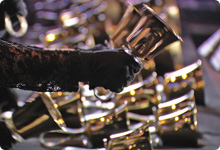Handbell Ensembles
What is a Handbell Ensemble?
 Consider a single instrument that takes many people to play. The individual notes in the handbell instrument each require a musician's hand upon it, to place its tone in exact relationship with the other notes in the score, all in the shared context of rhythm, tempo, dynamics, articulation, and the overall musical line. This extremely complex process becomes second nature to the virtuoso handbell musician, who, like a pianist, must be aware of the character of the entire work, while controlling only a few of the tones in the instrument.
Consider a single instrument that takes many people to play. The individual notes in the handbell instrument each require a musician's hand upon it, to place its tone in exact relationship with the other notes in the score, all in the shared context of rhythm, tempo, dynamics, articulation, and the overall musical line. This extremely complex process becomes second nature to the virtuoso handbell musician, who, like a pianist, must be aware of the character of the entire work, while controlling only a few of the tones in the instrument.
This instrument consists of a variable number of cast bronze bells fitted to flexible handles and equipped with clapper mechanisms that move in a single plane, striking the casting at only two places (forward and back). The tone of the bells can be varied by the tuning of the overtones at the time of manufacture, or by changing the density of the clappers at the strikepoints during performance. Similar tuned instruments with clappers can be made from other materials, such as handchimes made from aluminum, which produce different but compatible timbres. The differing sounds of the various makes of bells and chimes give the artistic director a symphonic palette of timbres to use separately and in conjunction to achieve his or her creative vision for the works under direction.
A set of handbells can range from a single octave (12 or 13 bells, depending on the accidentals) up to seven octaves, though most ensembles perform on five octaves, or 61 bells. Skilled handbell musicians can play as many as six bells at one time or in quick succession. Sonos performs on four and a half octaves of Malmarks, an octave of bass Schulmerichs, five octaves of Malmark handchimes, and five octaves of English-made Whitechapel handbells, as well as a variety of other percussion instruments.
 The fascination in watching a superb handbell ensemble perform lies for many people in the completely intuitive relationship the dozen or so musicians must achieve with each other. A pianist or flutist, for example, has one brain controlling two hands and delivers a musical whole in his or her unique style. Imagine if the flutist joined a flute choir that divided up the grand staff, wherein each flutist was assigned sole responsibility for three or four of the notes, and was instructed to play only these notes where they occurred in the score and no others--and in addition, the flutists must all join their notes seamlessly, so that the result is musically pleasing! When many brains control many hands, the results can be less than pleasing if the ensemble is not trained to work together as one.
The fascination in watching a superb handbell ensemble perform lies for many people in the completely intuitive relationship the dozen or so musicians must achieve with each other. A pianist or flutist, for example, has one brain controlling two hands and delivers a musical whole in his or her unique style. Imagine if the flutist joined a flute choir that divided up the grand staff, wherein each flutist was assigned sole responsibility for three or four of the notes, and was instructed to play only these notes where they occurred in the score and no others--and in addition, the flutists must all join their notes seamlessly, so that the result is musically pleasing! When many brains control many hands, the results can be less than pleasing if the ensemble is not trained to work together as one.
Sonosian musicians, having achieved their musical expertise on a variety of other instruments, are attracted to the complexity and dance-like challenge of performing on handbells. This instrument requires great personal discipline, a high level of cooperation, extremely good rhythm, and a willingness to become a component of a musical whole in which the communion of all parts is essential to the success of the ensemble. Audiences around the world are awed by the intimacy of this amazing musical relationship.

